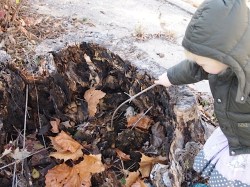
Emma MarrisPoking a puffball fungus to watch spores explode.
You know that feeling when you are running late, and you’re trying desperately to get little kids moving? You are frantically searching for your keys and replying to text messages; they are putting their socks in the fridge. You are pushing the stroller with the baby brother down the street with a purposeful stride; they are poking their fingers into muddy puddles, assessing their temperature. You are on the corner, barking at them to “hurry up!” They are explaining patiently that they need three sticks before they could possibly consider crossing the street.
And then, you know that feeling when you aren’t running late, when your next appointment is a snack or a bedtime still hours in the future, and yet you are still frantically searching for your keys, striding down the street, and barking at your children to “hurry up!”? Our kids must think we are nuts.
I write about environmental science for a living, and I consider myself a pretty big nature fan. When I’m out in a park on an officially nature-centric outing, I am able to slow down, calm down, and really enjoy the flora and fauna, large and small. And my kids get free rein. I soak my feet in the water and watch them peek under rocks and count ladybug spots and identify birds and unsuccessfully beg to pick flowers. But despite actively writing about the importance of seeing nature all around us, about expanding our concern for biodiversity out past the boundaries of our beloved protected areas and into the humanized spaces where we spend much of our lives, I still rush. I rush when I walk alone and I rush my kids down the sidewalk.
So, I tried to stop. When my oldest was about 2, I began taking her on walks where I was not allowed to rush her, suggest we move on, use the words “hurry up,” or anything like that. And it was really, really hard. Every neuron in my brain would be telling me to keep the forward momentum going, and my daughter would be cheerfully oblivious to my distress, sitting on our neighbor’s parking strip, tearing a dandelion to shreds.
But I persevered, mostly. “Walks” ground down into (real) hangouts. We spent 20 minutes looking at a neighborhood pepper plant. I grew tired of standing and bending and ended up sitting on the sidewalk myself. Not rushing one’s kids does get easier, especially once you actually sit down. But the extreme difficulty I had testifies to the unrelenting pace of our lives. We rush, rush, rush — and yet manage to spend most of our time dinking around on the internet. Why not dink around in nature instead?
If that’s our goal, toddlers make excellent mentors: They’re built for this work. Crucially, they are low to the ground, where much of the action is. They routinely see objects I am just too far up to notice. Once they’ve spotted an interesting object, they can squat forever, not needing to sit on wet or snowy observation days. Additionally, their tiny hands are ideal, once they get the fine motor thing working, for picking up insects, tiny fragile eggshells, individual grains of sand, and wisps of dried grass. And, perhaps most importantly, they haven’t been indoctrinated as to which species and items are worthy of attention.
To the toddler, the clover flower is as splendid as the dahlia; the dried worm as tragic as a starving polar bear; the walnut shell as mysterious as the queen conch. The lesson to us is that while we unconsciously rank and sort nature into human-centric categories of lesser or greater value, from despised invasive weeds to iconic endangered species, kids just see a bunch of interesting and beautiful stuff. And they are right. It is all interesting; it is all beautiful; it is all nature.
That doesn’t mean we shouldn’t spend millions to save the tiger, because after all there are lots of snails still. Nor does it mean we shouldn’t try to rout out those non-natives in places where they are causing harm, according to our conservation goals for a site. But it does mean that there is a lot of pleasure out there going wanting because we grownups are too snobby to take it: a lot of robin’s nests to be located; a lot of squirrel routes to map; a lot of sticks that make excellent magic wands.
To amuse myself during these “walks,” I found myself doing a bit of close observation myself. I grew very interested in leaf galls, which were numerous and varied in our neighborhood in Missouri. I would then look them up after we arrived home, an hour and 20 feet or so later, and learn about their life cycle. The kids and I even dissected a few galls to find the little wasp larvae inside.
I would like to say that my overall stress level decreased as a result of my practice of toddler zen walks. Alas, they were too infrequent. Now that we’ve moved to Klamath Falls, Ore., and the baby is taking his first steps, I plan to bring them back. They are as difficult and rewarding as meditation, plus you don’t need anyone to mind the kids. And what better way to learn about the ecology of my new town than to observe it from two feet off the ground at .01 miles per hour?



